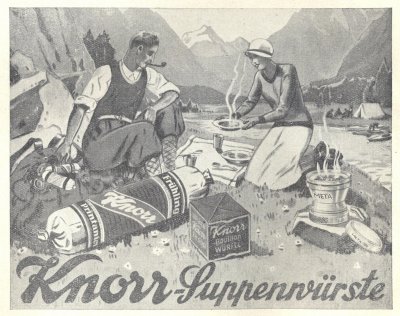Heeresbergführer
Familiar Face
- Messages
- 90
- Location
- The Mountains of Life
Grüß Di' Reno Kid,
Here's a period Knorr ad from a 1933 Swiss Alpine Club magazine "Die Alpen."

Horrido!
Patrick
Here's a period Knorr ad from a 1933 Swiss Alpine Club magazine "Die Alpen."

Horrido!
Patrick
I probably should just start a new thread, but this fits here, so I'm resurrecting this one...
In several old hiking/expedition/outfitting publications dating from the 1880s thru the 1920s I've seen references to something called "Erbswurst," an item highly recommended for provisioning (literal translation: "pea sausage"). I didn't have a clue what it was and so I just assumed it was another of those things lost to the mists of time. Well, Mrs. Reno Kid and I re-located to Germany a few months ago. We were in a local store last weekend and I spotted a sausage shaped package in the Knorr soup aisle labeled "Erbswurst." It was only about €1.25 (about $1.66), so I bought one.
Intrigued, I started doing a bit of research. It is indeed the same stuff that I had read about in the old books. Knorr has been making it since 1889, when they bought the production rights from the original manufacturer. It was originally invented(?) in the 1860s as a field ration for German soldiers. A lot of troops lived on not much more than Erbswurst and brown bread for the a lot of the Franco-Prussian War of 1870-71. In fact, it was a standard field ration until the 1950s or 60s. It appears that the packaging hasn't even changed much in the last hundred years. It comes in two varieties--green and yellow. I've read that the only difference is the color of the peas used.
View attachment 3728
So what is it? Basically, it's pea soup with tiny bits of de-fatted bacon and spices for flavor. When you open the package, it contains six tablets of compressed, dry pea soup. You crush a tablet in a suitable cooking cup or pot and add 1/4 liter (a little more than one cup, U.S.) cold water, and heat to boiling. In about three minutes, you have a thick and surprisingly filling pea soup. I finally got around to trying it today for lunch and it's actually pretty good. It's not the best pea soup I've ever had but it's not the worst, either. I tried the green variety. After a long walk on a crisp day on the trail, this would be pretty good eating. Of course, it has an expiration date like everything else, but at least one of the old books said it lasts virtually forever. To paraphrase the author, "...after three years, it will taste no worse that it does today--it won't taste any better but it won't taste worse." Anyway, I will be adding it to my trail rations. I don't know how easy it is to get outside Germany, but it would be worth looking for.